UGB264 Business Ethics, Responsibility & Sustainability - Clothing
VerifiedAdded on 2023/01/11
|11
|3769
|81
Essay
AI Summary
This essay provides an in-depth analysis of business ethics, corporate responsibility, and sustainability within the clothing industry. It begins by examining key challenges such as the cost of materials, consumer sentiments, higher government regulations, and labor disruptions. The essay then analyzes and explains best practices for addressing ethical and moral issues, highlighting the importance of supply chain transparency, optimum resource utilization, and interdisciplinary approaches. Furthermore, recommendations are made for businesses in the clothing industry to demonstrate responsibility by considering global factors, including promoting supply chain transparency, optimizing resource usage, and fostering interdisciplinary collaboration. The paper concludes by emphasizing the significance of ethical practices, sustainability, and corporate responsibility for long-term success and positive societal impact in the clothing sector. Desklib is a platform where students can find similar essays and study resources.
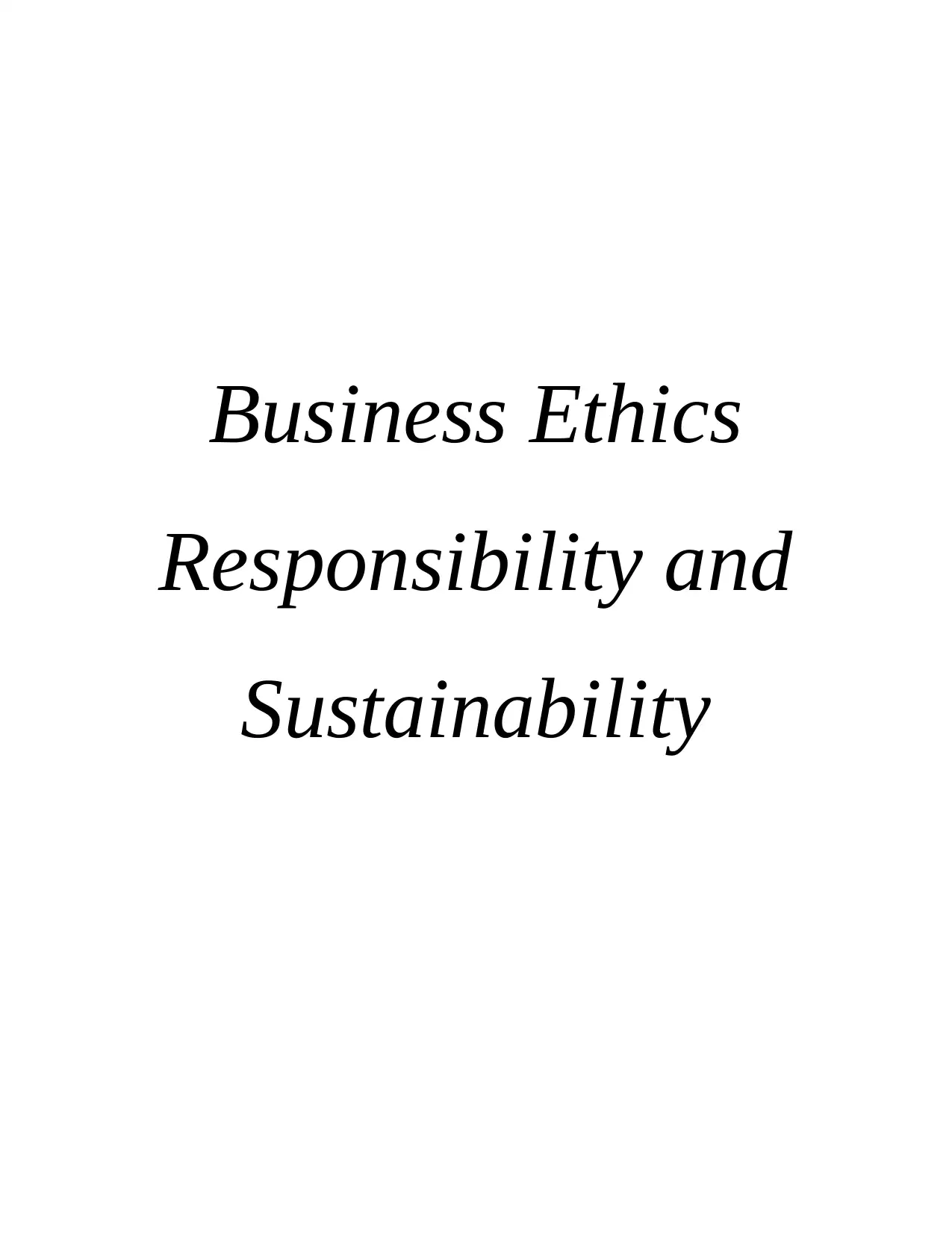
Business Ethics
Responsibility and
Sustainability
Responsibility and
Sustainability
Paraphrase This Document
Need a fresh take? Get an instant paraphrase of this document with our AI Paraphraser
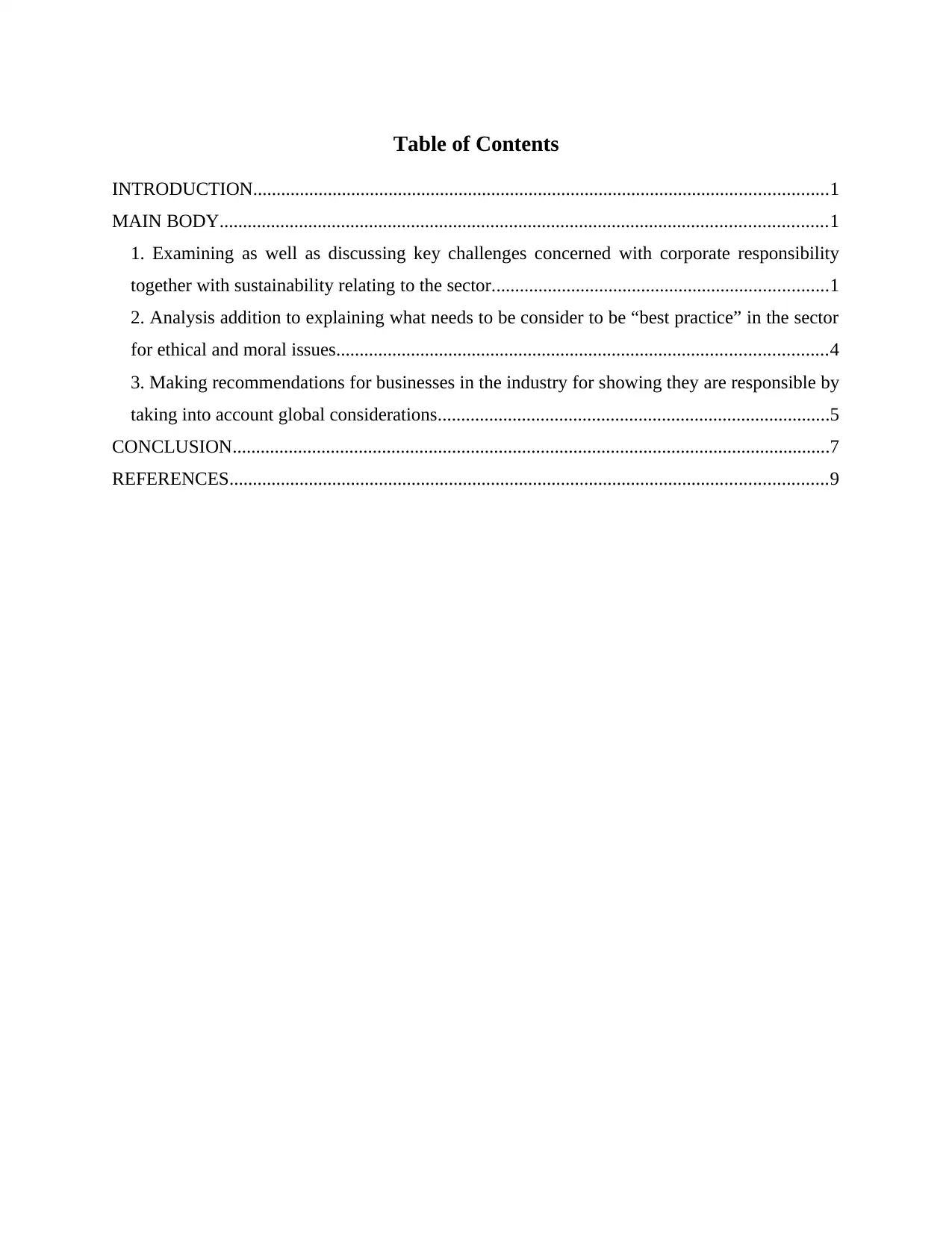
Table of Contents
INTRODUCTION...........................................................................................................................1
MAIN BODY..................................................................................................................................1
1. Examining as well as discussing key challenges concerned with corporate responsibility
together with sustainability relating to the sector........................................................................1
2. Analysis addition to explaining what needs to be consider to be “best practice” in the sector
for ethical and moral issues.........................................................................................................4
3. Making recommendations for businesses in the industry for showing they are responsible by
taking into account global considerations....................................................................................5
CONCLUSION................................................................................................................................7
REFERENCES................................................................................................................................9
INTRODUCTION...........................................................................................................................1
MAIN BODY..................................................................................................................................1
1. Examining as well as discussing key challenges concerned with corporate responsibility
together with sustainability relating to the sector........................................................................1
2. Analysis addition to explaining what needs to be consider to be “best practice” in the sector
for ethical and moral issues.........................................................................................................4
3. Making recommendations for businesses in the industry for showing they are responsible by
taking into account global considerations....................................................................................5
CONCLUSION................................................................................................................................7
REFERENCES................................................................................................................................9
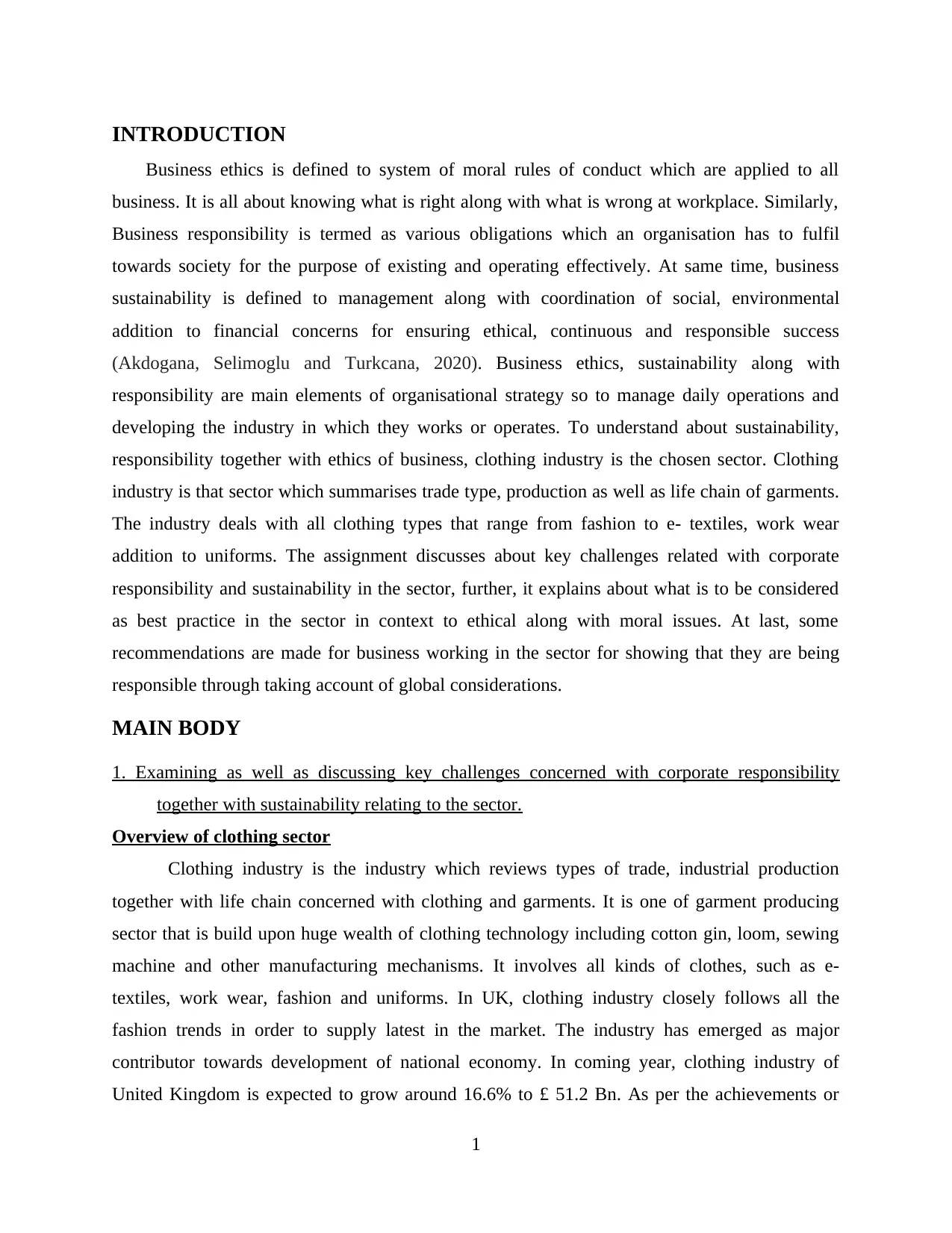
INTRODUCTION
Business ethics is defined to system of moral rules of conduct which are applied to all
business. It is all about knowing what is right along with what is wrong at workplace. Similarly,
Business responsibility is termed as various obligations which an organisation has to fulfil
towards society for the purpose of existing and operating effectively. At same time, business
sustainability is defined to management along with coordination of social, environmental
addition to financial concerns for ensuring ethical, continuous and responsible success
(Akdogana, Selimoglu and Turkcana, 2020). Business ethics, sustainability along with
responsibility are main elements of organisational strategy so to manage daily operations and
developing the industry in which they works or operates. To understand about sustainability,
responsibility together with ethics of business, clothing industry is the chosen sector. Clothing
industry is that sector which summarises trade type, production as well as life chain of garments.
The industry deals with all clothing types that range from fashion to e- textiles, work wear
addition to uniforms. The assignment discusses about key challenges related with corporate
responsibility and sustainability in the sector, further, it explains about what is to be considered
as best practice in the sector in context to ethical along with moral issues. At last, some
recommendations are made for business working in the sector for showing that they are being
responsible through taking account of global considerations.
MAIN BODY
1. Examining as well as discussing key challenges concerned with corporate responsibility
together with sustainability relating to the sector.
Overview of clothing sector
Clothing industry is the industry which reviews types of trade, industrial production
together with life chain concerned with clothing and garments. It is one of garment producing
sector that is build upon huge wealth of clothing technology including cotton gin, loom, sewing
machine and other manufacturing mechanisms. It involves all kinds of clothes, such as e-
textiles, work wear, fashion and uniforms. In UK, clothing industry closely follows all the
fashion trends in order to supply latest in the market. The industry has emerged as major
contributor towards development of national economy. In coming year, clothing industry of
United Kingdom is expected to grow around 16.6% to £ 51.2 Bn. As per the achievements or
1
Business ethics is defined to system of moral rules of conduct which are applied to all
business. It is all about knowing what is right along with what is wrong at workplace. Similarly,
Business responsibility is termed as various obligations which an organisation has to fulfil
towards society for the purpose of existing and operating effectively. At same time, business
sustainability is defined to management along with coordination of social, environmental
addition to financial concerns for ensuring ethical, continuous and responsible success
(Akdogana, Selimoglu and Turkcana, 2020). Business ethics, sustainability along with
responsibility are main elements of organisational strategy so to manage daily operations and
developing the industry in which they works or operates. To understand about sustainability,
responsibility together with ethics of business, clothing industry is the chosen sector. Clothing
industry is that sector which summarises trade type, production as well as life chain of garments.
The industry deals with all clothing types that range from fashion to e- textiles, work wear
addition to uniforms. The assignment discusses about key challenges related with corporate
responsibility and sustainability in the sector, further, it explains about what is to be considered
as best practice in the sector in context to ethical along with moral issues. At last, some
recommendations are made for business working in the sector for showing that they are being
responsible through taking account of global considerations.
MAIN BODY
1. Examining as well as discussing key challenges concerned with corporate responsibility
together with sustainability relating to the sector.
Overview of clothing sector
Clothing industry is the industry which reviews types of trade, industrial production
together with life chain concerned with clothing and garments. It is one of garment producing
sector that is build upon huge wealth of clothing technology including cotton gin, loom, sewing
machine and other manufacturing mechanisms. It involves all kinds of clothes, such as e-
textiles, work wear, fashion and uniforms. In UK, clothing industry closely follows all the
fashion trends in order to supply latest in the market. The industry has emerged as major
contributor towards development of national economy. In coming year, clothing industry of
United Kingdom is expected to grow around 16.6% to £ 51.2 Bn. As per the achievements or
1
⊘ This is a preview!⊘
Do you want full access?
Subscribe today to unlock all pages.

Trusted by 1+ million students worldwide
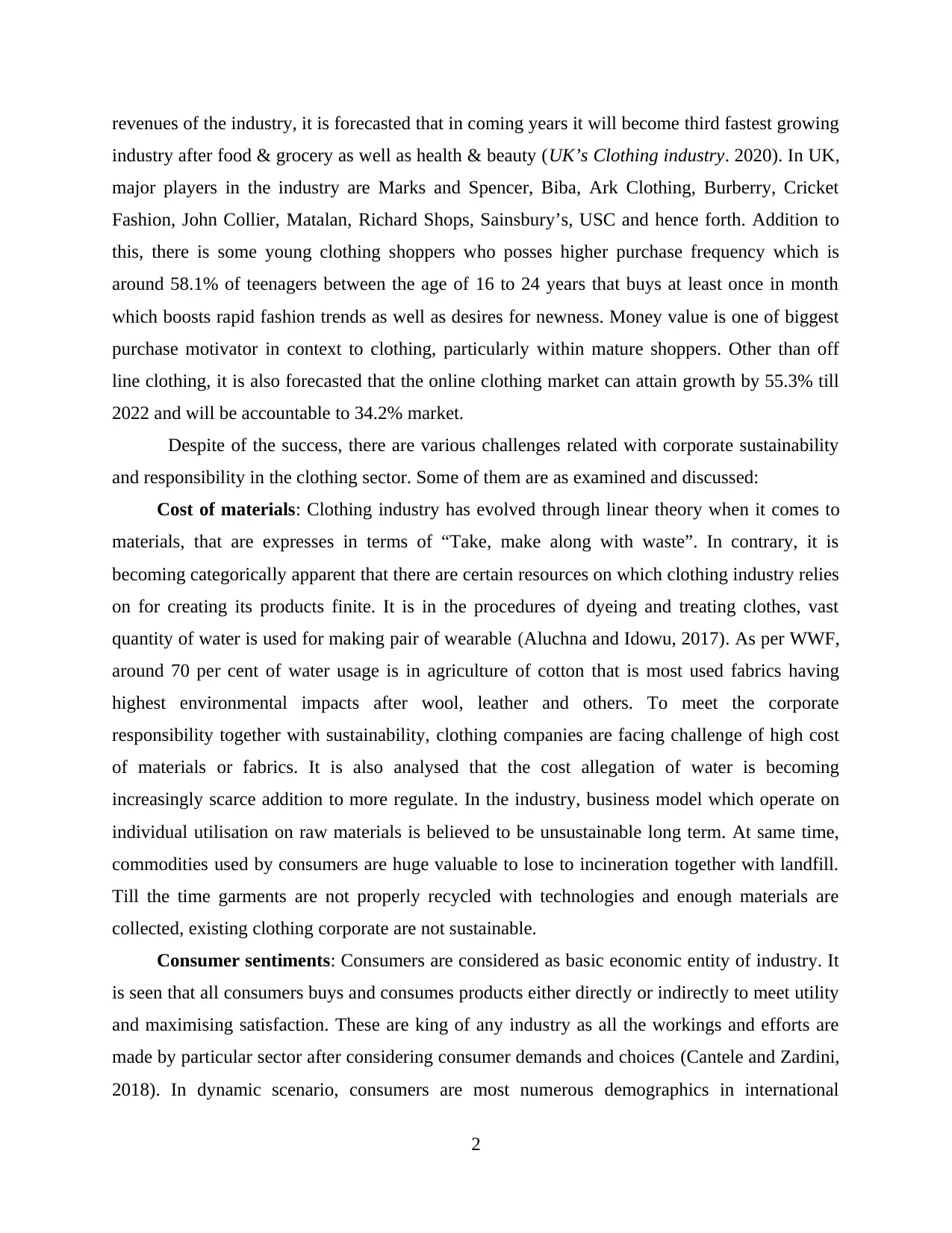
revenues of the industry, it is forecasted that in coming years it will become third fastest growing
industry after food & grocery as well as health & beauty (UK’s Clothing industry. 2020). In UK,
major players in the industry are Marks and Spencer, Biba, Ark Clothing, Burberry, Cricket
Fashion, John Collier, Matalan, Richard Shops, Sainsbury’s, USC and hence forth. Addition to
this, there is some young clothing shoppers who posses higher purchase frequency which is
around 58.1% of teenagers between the age of 16 to 24 years that buys at least once in month
which boosts rapid fashion trends as well as desires for newness. Money value is one of biggest
purchase motivator in context to clothing, particularly within mature shoppers. Other than off
line clothing, it is also forecasted that the online clothing market can attain growth by 55.3% till
2022 and will be accountable to 34.2% market.
Despite of the success, there are various challenges related with corporate sustainability
and responsibility in the clothing sector. Some of them are as examined and discussed:
Cost of materials: Clothing industry has evolved through linear theory when it comes to
materials, that are expresses in terms of “Take, make along with waste”. In contrary, it is
becoming categorically apparent that there are certain resources on which clothing industry relies
on for creating its products finite. It is in the procedures of dyeing and treating clothes, vast
quantity of water is used for making pair of wearable (Aluchna and Idowu, 2017). As per WWF,
around 70 per cent of water usage is in agriculture of cotton that is most used fabrics having
highest environmental impacts after wool, leather and others. To meet the corporate
responsibility together with sustainability, clothing companies are facing challenge of high cost
of materials or fabrics. It is also analysed that the cost allegation of water is becoming
increasingly scarce addition to more regulate. In the industry, business model which operate on
individual utilisation on raw materials is believed to be unsustainable long term. At same time,
commodities used by consumers are huge valuable to lose to incineration together with landfill.
Till the time garments are not properly recycled with technologies and enough materials are
collected, existing clothing corporate are not sustainable.
Consumer sentiments: Consumers are considered as basic economic entity of industry. It
is seen that all consumers buys and consumes products either directly or indirectly to meet utility
and maximising satisfaction. These are king of any industry as all the workings and efforts are
made by particular sector after considering consumer demands and choices (Cantele and Zardini,
2018). In dynamic scenario, consumers are most numerous demographics in international
2
industry after food & grocery as well as health & beauty (UK’s Clothing industry. 2020). In UK,
major players in the industry are Marks and Spencer, Biba, Ark Clothing, Burberry, Cricket
Fashion, John Collier, Matalan, Richard Shops, Sainsbury’s, USC and hence forth. Addition to
this, there is some young clothing shoppers who posses higher purchase frequency which is
around 58.1% of teenagers between the age of 16 to 24 years that buys at least once in month
which boosts rapid fashion trends as well as desires for newness. Money value is one of biggest
purchase motivator in context to clothing, particularly within mature shoppers. Other than off
line clothing, it is also forecasted that the online clothing market can attain growth by 55.3% till
2022 and will be accountable to 34.2% market.
Despite of the success, there are various challenges related with corporate sustainability
and responsibility in the clothing sector. Some of them are as examined and discussed:
Cost of materials: Clothing industry has evolved through linear theory when it comes to
materials, that are expresses in terms of “Take, make along with waste”. In contrary, it is
becoming categorically apparent that there are certain resources on which clothing industry relies
on for creating its products finite. It is in the procedures of dyeing and treating clothes, vast
quantity of water is used for making pair of wearable (Aluchna and Idowu, 2017). As per WWF,
around 70 per cent of water usage is in agriculture of cotton that is most used fabrics having
highest environmental impacts after wool, leather and others. To meet the corporate
responsibility together with sustainability, clothing companies are facing challenge of high cost
of materials or fabrics. It is also analysed that the cost allegation of water is becoming
increasingly scarce addition to more regulate. In the industry, business model which operate on
individual utilisation on raw materials is believed to be unsustainable long term. At same time,
commodities used by consumers are huge valuable to lose to incineration together with landfill.
Till the time garments are not properly recycled with technologies and enough materials are
collected, existing clothing corporate are not sustainable.
Consumer sentiments: Consumers are considered as basic economic entity of industry. It
is seen that all consumers buys and consumes products either directly or indirectly to meet utility
and maximising satisfaction. These are king of any industry as all the workings and efforts are
made by particular sector after considering consumer demands and choices (Cantele and Zardini,
2018). In dynamic scenario, consumers are most numerous demographics in international
2
Paraphrase This Document
Need a fresh take? Get an instant paraphrase of this document with our AI Paraphraser
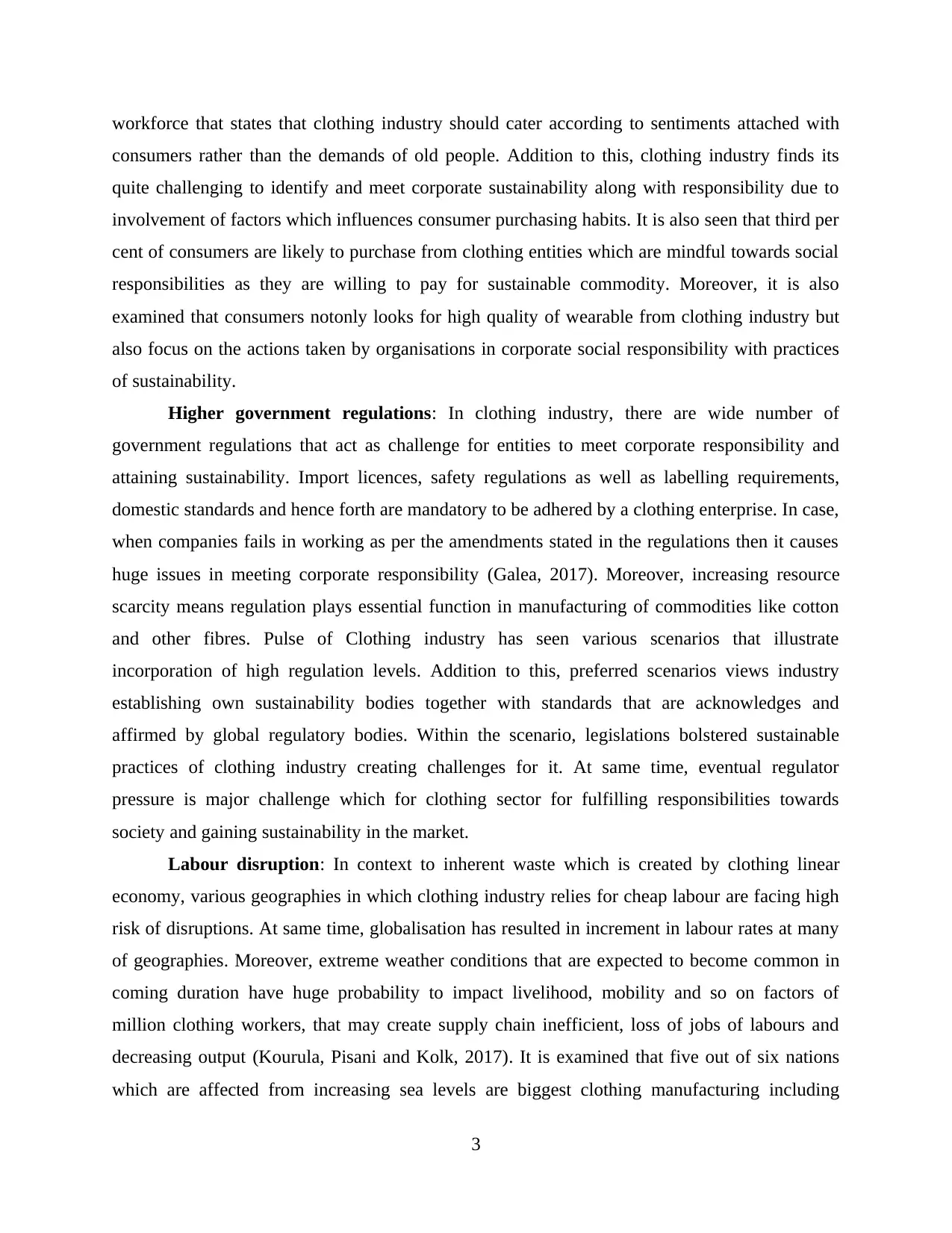
workforce that states that clothing industry should cater according to sentiments attached with
consumers rather than the demands of old people. Addition to this, clothing industry finds its
quite challenging to identify and meet corporate sustainability along with responsibility due to
involvement of factors which influences consumer purchasing habits. It is also seen that third per
cent of consumers are likely to purchase from clothing entities which are mindful towards social
responsibilities as they are willing to pay for sustainable commodity. Moreover, it is also
examined that consumers notonly looks for high quality of wearable from clothing industry but
also focus on the actions taken by organisations in corporate social responsibility with practices
of sustainability.
Higher government regulations: In clothing industry, there are wide number of
government regulations that act as challenge for entities to meet corporate responsibility and
attaining sustainability. Import licences, safety regulations as well as labelling requirements,
domestic standards and hence forth are mandatory to be adhered by a clothing enterprise. In case,
when companies fails in working as per the amendments stated in the regulations then it causes
huge issues in meeting corporate responsibility (Galea, 2017). Moreover, increasing resource
scarcity means regulation plays essential function in manufacturing of commodities like cotton
and other fibres. Pulse of Clothing industry has seen various scenarios that illustrate
incorporation of high regulation levels. Addition to this, preferred scenarios views industry
establishing own sustainability bodies together with standards that are acknowledges and
affirmed by global regulatory bodies. Within the scenario, legislations bolstered sustainable
practices of clothing industry creating challenges for it. At same time, eventual regulator
pressure is major challenge which for clothing sector for fulfilling responsibilities towards
society and gaining sustainability in the market.
Labour disruption: In context to inherent waste which is created by clothing linear
economy, various geographies in which clothing industry relies for cheap labour are facing high
risk of disruptions. At same time, globalisation has resulted in increment in labour rates at many
of geographies. Moreover, extreme weather conditions that are expected to become common in
coming duration have huge probability to impact livelihood, mobility and so on factors of
million clothing workers, that may create supply chain inefficient, loss of jobs of labours and
decreasing output (Kourula, Pisani and Kolk, 2017). It is examined that five out of six nations
which are affected from increasing sea levels are biggest clothing manufacturing including
3
consumers rather than the demands of old people. Addition to this, clothing industry finds its
quite challenging to identify and meet corporate sustainability along with responsibility due to
involvement of factors which influences consumer purchasing habits. It is also seen that third per
cent of consumers are likely to purchase from clothing entities which are mindful towards social
responsibilities as they are willing to pay for sustainable commodity. Moreover, it is also
examined that consumers notonly looks for high quality of wearable from clothing industry but
also focus on the actions taken by organisations in corporate social responsibility with practices
of sustainability.
Higher government regulations: In clothing industry, there are wide number of
government regulations that act as challenge for entities to meet corporate responsibility and
attaining sustainability. Import licences, safety regulations as well as labelling requirements,
domestic standards and hence forth are mandatory to be adhered by a clothing enterprise. In case,
when companies fails in working as per the amendments stated in the regulations then it causes
huge issues in meeting corporate responsibility (Galea, 2017). Moreover, increasing resource
scarcity means regulation plays essential function in manufacturing of commodities like cotton
and other fibres. Pulse of Clothing industry has seen various scenarios that illustrate
incorporation of high regulation levels. Addition to this, preferred scenarios views industry
establishing own sustainability bodies together with standards that are acknowledges and
affirmed by global regulatory bodies. Within the scenario, legislations bolstered sustainable
practices of clothing industry creating challenges for it. At same time, eventual regulator
pressure is major challenge which for clothing sector for fulfilling responsibilities towards
society and gaining sustainability in the market.
Labour disruption: In context to inherent waste which is created by clothing linear
economy, various geographies in which clothing industry relies for cheap labour are facing high
risk of disruptions. At same time, globalisation has resulted in increment in labour rates at many
of geographies. Moreover, extreme weather conditions that are expected to become common in
coming duration have huge probability to impact livelihood, mobility and so on factors of
million clothing workers, that may create supply chain inefficient, loss of jobs of labours and
decreasing output (Kourula, Pisani and Kolk, 2017). It is examined that five out of six nations
which are affected from increasing sea levels are biggest clothing manufacturing including
3
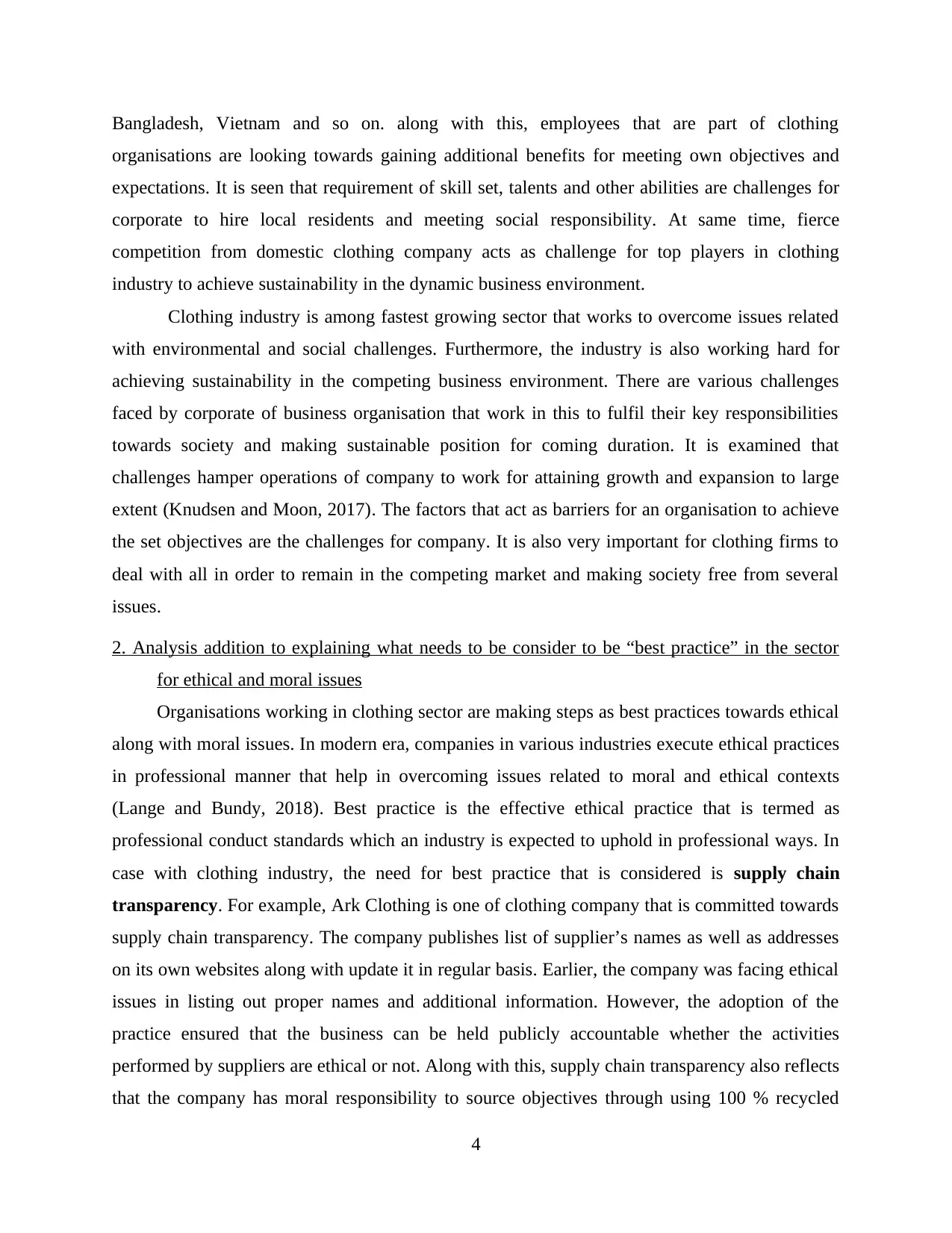
Bangladesh, Vietnam and so on. along with this, employees that are part of clothing
organisations are looking towards gaining additional benefits for meeting own objectives and
expectations. It is seen that requirement of skill set, talents and other abilities are challenges for
corporate to hire local residents and meeting social responsibility. At same time, fierce
competition from domestic clothing company acts as challenge for top players in clothing
industry to achieve sustainability in the dynamic business environment.
Clothing industry is among fastest growing sector that works to overcome issues related
with environmental and social challenges. Furthermore, the industry is also working hard for
achieving sustainability in the competing business environment. There are various challenges
faced by corporate of business organisation that work in this to fulfil their key responsibilities
towards society and making sustainable position for coming duration. It is examined that
challenges hamper operations of company to work for attaining growth and expansion to large
extent (Knudsen and Moon, 2017). The factors that act as barriers for an organisation to achieve
the set objectives are the challenges for company. It is also very important for clothing firms to
deal with all in order to remain in the competing market and making society free from several
issues.
2. Analysis addition to explaining what needs to be consider to be “best practice” in the sector
for ethical and moral issues
Organisations working in clothing sector are making steps as best practices towards ethical
along with moral issues. In modern era, companies in various industries execute ethical practices
in professional manner that help in overcoming issues related to moral and ethical contexts
(Lange and Bundy, 2018). Best practice is the effective ethical practice that is termed as
professional conduct standards which an industry is expected to uphold in professional ways. In
case with clothing industry, the need for best practice that is considered is supply chain
transparency. For example, Ark Clothing is one of clothing company that is committed towards
supply chain transparency. The company publishes list of supplier’s names as well as addresses
on its own websites along with update it in regular basis. Earlier, the company was facing ethical
issues in listing out proper names and additional information. However, the adoption of the
practice ensured that the business can be held publicly accountable whether the activities
performed by suppliers are ethical or not. Along with this, supply chain transparency also reflects
that the company has moral responsibility to source objectives through using 100 % recycled
4
organisations are looking towards gaining additional benefits for meeting own objectives and
expectations. It is seen that requirement of skill set, talents and other abilities are challenges for
corporate to hire local residents and meeting social responsibility. At same time, fierce
competition from domestic clothing company acts as challenge for top players in clothing
industry to achieve sustainability in the dynamic business environment.
Clothing industry is among fastest growing sector that works to overcome issues related
with environmental and social challenges. Furthermore, the industry is also working hard for
achieving sustainability in the competing business environment. There are various challenges
faced by corporate of business organisation that work in this to fulfil their key responsibilities
towards society and making sustainable position for coming duration. It is examined that
challenges hamper operations of company to work for attaining growth and expansion to large
extent (Knudsen and Moon, 2017). The factors that act as barriers for an organisation to achieve
the set objectives are the challenges for company. It is also very important for clothing firms to
deal with all in order to remain in the competing market and making society free from several
issues.
2. Analysis addition to explaining what needs to be consider to be “best practice” in the sector
for ethical and moral issues
Organisations working in clothing sector are making steps as best practices towards ethical
along with moral issues. In modern era, companies in various industries execute ethical practices
in professional manner that help in overcoming issues related to moral and ethical contexts
(Lange and Bundy, 2018). Best practice is the effective ethical practice that is termed as
professional conduct standards which an industry is expected to uphold in professional ways. In
case with clothing industry, the need for best practice that is considered is supply chain
transparency. For example, Ark Clothing is one of clothing company that is committed towards
supply chain transparency. The company publishes list of supplier’s names as well as addresses
on its own websites along with update it in regular basis. Earlier, the company was facing ethical
issues in listing out proper names and additional information. However, the adoption of the
practice ensured that the business can be held publicly accountable whether the activities
performed by suppliers are ethical or not. Along with this, supply chain transparency also reflects
that the company has moral responsibility to source objectives through using 100 % recycled
4
⊘ This is a preview!⊘
Do you want full access?
Subscribe today to unlock all pages.

Trusted by 1+ million students worldwide
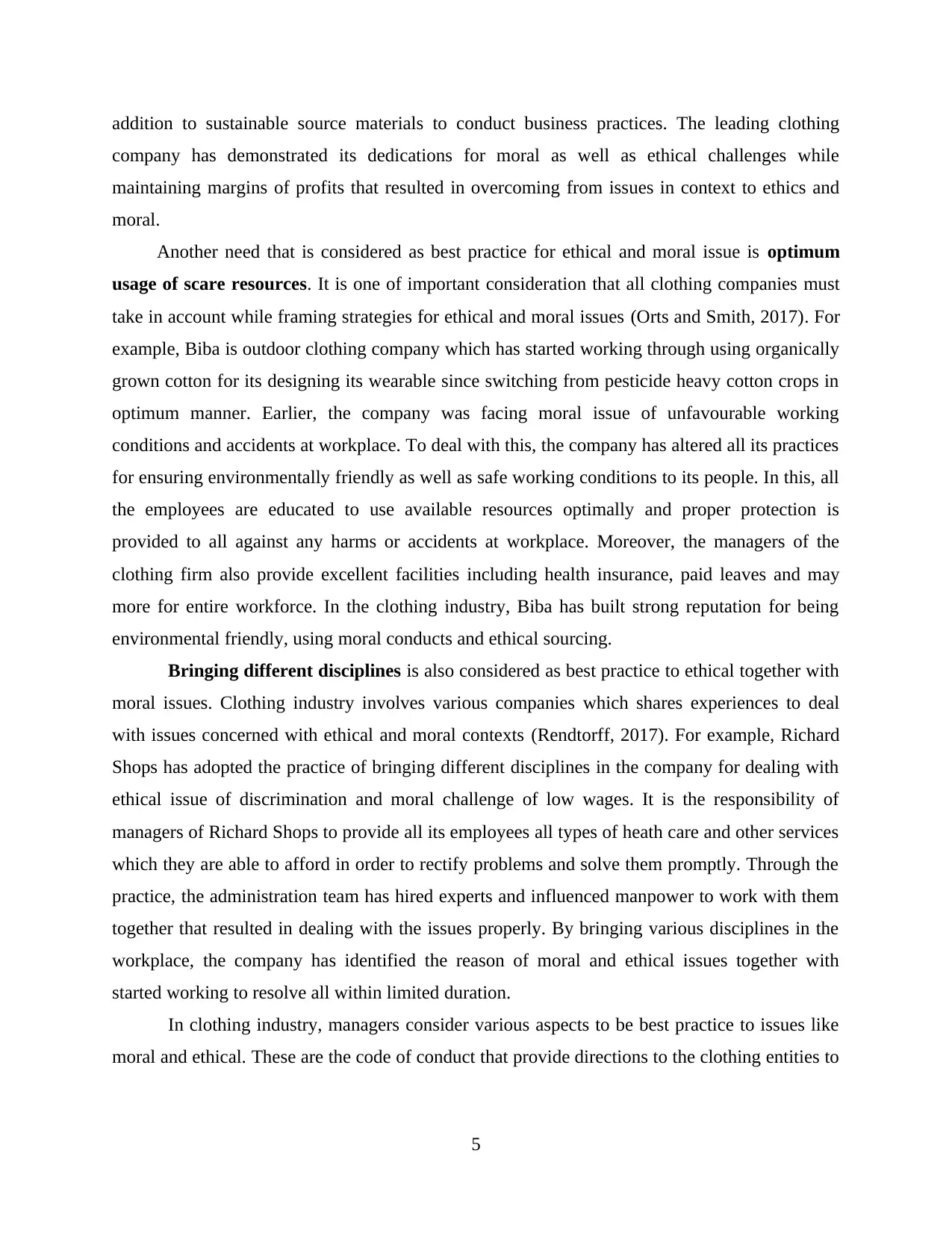
addition to sustainable source materials to conduct business practices. The leading clothing
company has demonstrated its dedications for moral as well as ethical challenges while
maintaining margins of profits that resulted in overcoming from issues in context to ethics and
moral.
Another need that is considered as best practice for ethical and moral issue is optimum
usage of scare resources. It is one of important consideration that all clothing companies must
take in account while framing strategies for ethical and moral issues (Orts and Smith, 2017). For
example, Biba is outdoor clothing company which has started working through using organically
grown cotton for its designing its wearable since switching from pesticide heavy cotton crops in
optimum manner. Earlier, the company was facing moral issue of unfavourable working
conditions and accidents at workplace. To deal with this, the company has altered all its practices
for ensuring environmentally friendly as well as safe working conditions to its people. In this, all
the employees are educated to use available resources optimally and proper protection is
provided to all against any harms or accidents at workplace. Moreover, the managers of the
clothing firm also provide excellent facilities including health insurance, paid leaves and may
more for entire workforce. In the clothing industry, Biba has built strong reputation for being
environmental friendly, using moral conducts and ethical sourcing.
Bringing different disciplines is also considered as best practice to ethical together with
moral issues. Clothing industry involves various companies which shares experiences to deal
with issues concerned with ethical and moral contexts (Rendtorff, 2017). For example, Richard
Shops has adopted the practice of bringing different disciplines in the company for dealing with
ethical issue of discrimination and moral challenge of low wages. It is the responsibility of
managers of Richard Shops to provide all its employees all types of heath care and other services
which they are able to afford in order to rectify problems and solve them promptly. Through the
practice, the administration team has hired experts and influenced manpower to work with them
together that resulted in dealing with the issues properly. By bringing various disciplines in the
workplace, the company has identified the reason of moral and ethical issues together with
started working to resolve all within limited duration.
In clothing industry, managers consider various aspects to be best practice to issues like
moral and ethical. These are the code of conduct that provide directions to the clothing entities to
5
company has demonstrated its dedications for moral as well as ethical challenges while
maintaining margins of profits that resulted in overcoming from issues in context to ethics and
moral.
Another need that is considered as best practice for ethical and moral issue is optimum
usage of scare resources. It is one of important consideration that all clothing companies must
take in account while framing strategies for ethical and moral issues (Orts and Smith, 2017). For
example, Biba is outdoor clothing company which has started working through using organically
grown cotton for its designing its wearable since switching from pesticide heavy cotton crops in
optimum manner. Earlier, the company was facing moral issue of unfavourable working
conditions and accidents at workplace. To deal with this, the company has altered all its practices
for ensuring environmentally friendly as well as safe working conditions to its people. In this, all
the employees are educated to use available resources optimally and proper protection is
provided to all against any harms or accidents at workplace. Moreover, the managers of the
clothing firm also provide excellent facilities including health insurance, paid leaves and may
more for entire workforce. In the clothing industry, Biba has built strong reputation for being
environmental friendly, using moral conducts and ethical sourcing.
Bringing different disciplines is also considered as best practice to ethical together with
moral issues. Clothing industry involves various companies which shares experiences to deal
with issues concerned with ethical and moral contexts (Rendtorff, 2017). For example, Richard
Shops has adopted the practice of bringing different disciplines in the company for dealing with
ethical issue of discrimination and moral challenge of low wages. It is the responsibility of
managers of Richard Shops to provide all its employees all types of heath care and other services
which they are able to afford in order to rectify problems and solve them promptly. Through the
practice, the administration team has hired experts and influenced manpower to work with them
together that resulted in dealing with the issues properly. By bringing various disciplines in the
workplace, the company has identified the reason of moral and ethical issues together with
started working to resolve all within limited duration.
In clothing industry, managers consider various aspects to be best practice to issues like
moral and ethical. These are the code of conduct that provide directions to the clothing entities to
5
Paraphrase This Document
Need a fresh take? Get an instant paraphrase of this document with our AI Paraphraser
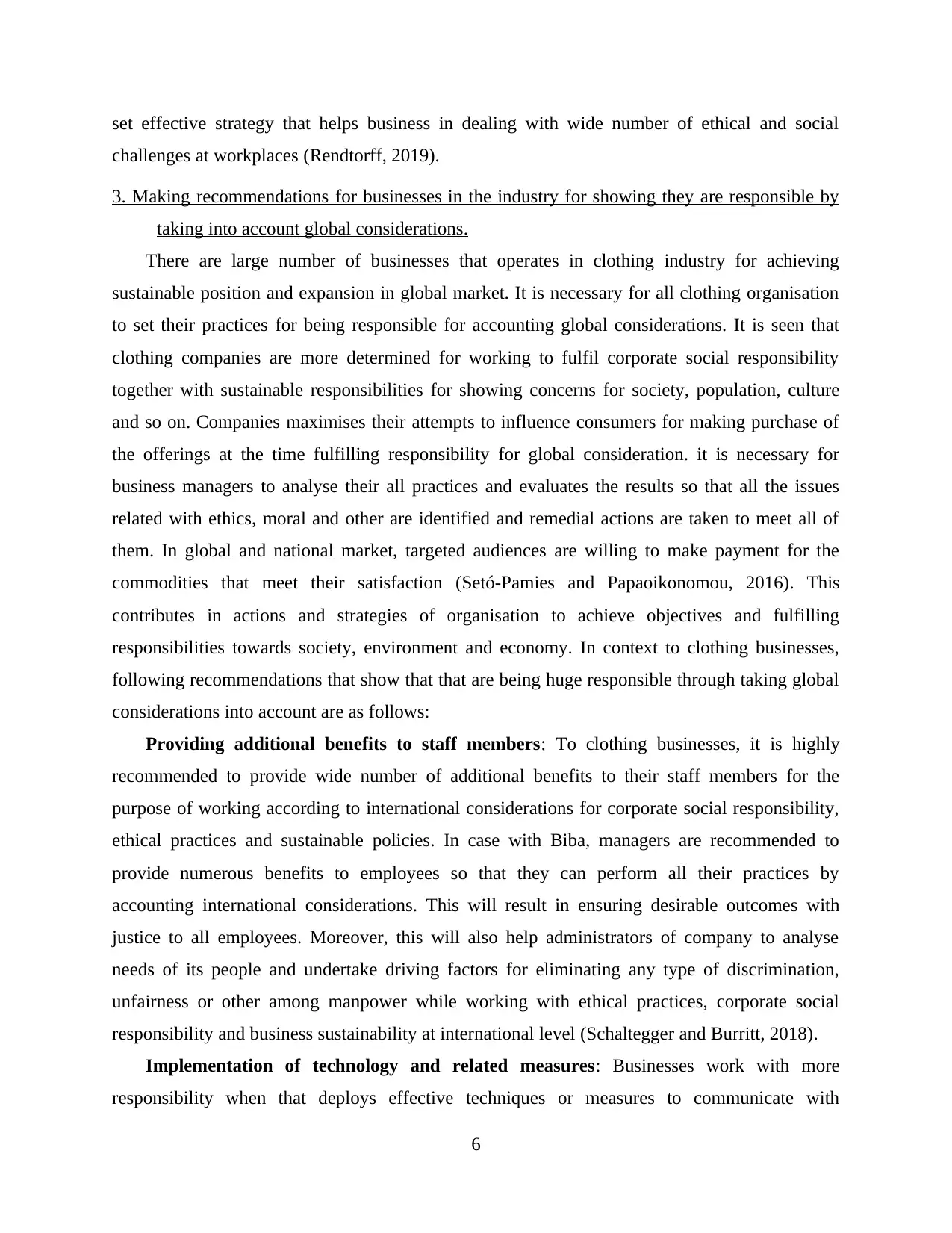
set effective strategy that helps business in dealing with wide number of ethical and social
challenges at workplaces (Rendtorff, 2019).
3. Making recommendations for businesses in the industry for showing they are responsible by
taking into account global considerations.
There are large number of businesses that operates in clothing industry for achieving
sustainable position and expansion in global market. It is necessary for all clothing organisation
to set their practices for being responsible for accounting global considerations. It is seen that
clothing companies are more determined for working to fulfil corporate social responsibility
together with sustainable responsibilities for showing concerns for society, population, culture
and so on. Companies maximises their attempts to influence consumers for making purchase of
the offerings at the time fulfilling responsibility for global consideration. it is necessary for
business managers to analyse their all practices and evaluates the results so that all the issues
related with ethics, moral and other are identified and remedial actions are taken to meet all of
them. In global and national market, targeted audiences are willing to make payment for the
commodities that meet their satisfaction (Setó-Pamies and Papaoikonomou, 2016). This
contributes in actions and strategies of organisation to achieve objectives and fulfilling
responsibilities towards society, environment and economy. In context to clothing businesses,
following recommendations that show that that are being huge responsible through taking global
considerations into account are as follows:
Providing additional benefits to staff members: To clothing businesses, it is highly
recommended to provide wide number of additional benefits to their staff members for the
purpose of working according to international considerations for corporate social responsibility,
ethical practices and sustainable policies. In case with Biba, managers are recommended to
provide numerous benefits to employees so that they can perform all their practices by
accounting international considerations. This will result in ensuring desirable outcomes with
justice to all employees. Moreover, this will also help administrators of company to analyse
needs of its people and undertake driving factors for eliminating any type of discrimination,
unfairness or other among manpower while working with ethical practices, corporate social
responsibility and business sustainability at international level (Schaltegger and Burritt, 2018).
Implementation of technology and related measures: Businesses work with more
responsibility when that deploys effective techniques or measures to communicate with
6
challenges at workplaces (Rendtorff, 2019).
3. Making recommendations for businesses in the industry for showing they are responsible by
taking into account global considerations.
There are large number of businesses that operates in clothing industry for achieving
sustainable position and expansion in global market. It is necessary for all clothing organisation
to set their practices for being responsible for accounting global considerations. It is seen that
clothing companies are more determined for working to fulfil corporate social responsibility
together with sustainable responsibilities for showing concerns for society, population, culture
and so on. Companies maximises their attempts to influence consumers for making purchase of
the offerings at the time fulfilling responsibility for global consideration. it is necessary for
business managers to analyse their all practices and evaluates the results so that all the issues
related with ethics, moral and other are identified and remedial actions are taken to meet all of
them. In global and national market, targeted audiences are willing to make payment for the
commodities that meet their satisfaction (Setó-Pamies and Papaoikonomou, 2016). This
contributes in actions and strategies of organisation to achieve objectives and fulfilling
responsibilities towards society, environment and economy. In context to clothing businesses,
following recommendations that show that that are being huge responsible through taking global
considerations into account are as follows:
Providing additional benefits to staff members: To clothing businesses, it is highly
recommended to provide wide number of additional benefits to their staff members for the
purpose of working according to international considerations for corporate social responsibility,
ethical practices and sustainable policies. In case with Biba, managers are recommended to
provide numerous benefits to employees so that they can perform all their practices by
accounting international considerations. This will result in ensuring desirable outcomes with
justice to all employees. Moreover, this will also help administrators of company to analyse
needs of its people and undertake driving factors for eliminating any type of discrimination,
unfairness or other among manpower while working with ethical practices, corporate social
responsibility and business sustainability at international level (Schaltegger and Burritt, 2018).
Implementation of technology and related measures: Businesses work with more
responsibility when that deploys effective techniques or measures to communicate with
6
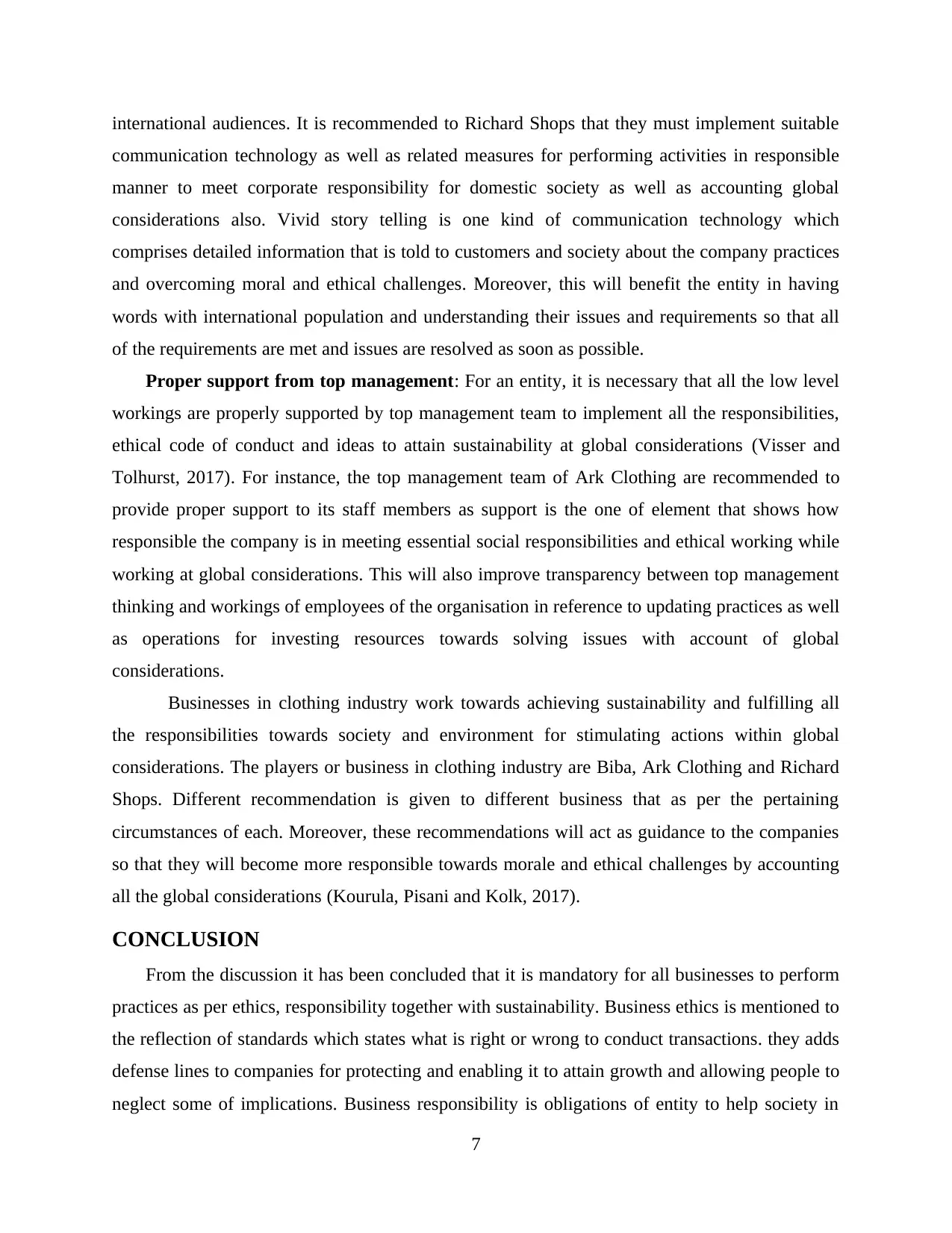
international audiences. It is recommended to Richard Shops that they must implement suitable
communication technology as well as related measures for performing activities in responsible
manner to meet corporate responsibility for domestic society as well as accounting global
considerations also. Vivid story telling is one kind of communication technology which
comprises detailed information that is told to customers and society about the company practices
and overcoming moral and ethical challenges. Moreover, this will benefit the entity in having
words with international population and understanding their issues and requirements so that all
of the requirements are met and issues are resolved as soon as possible.
Proper support from top management: For an entity, it is necessary that all the low level
workings are properly supported by top management team to implement all the responsibilities,
ethical code of conduct and ideas to attain sustainability at global considerations (Visser and
Tolhurst, 2017). For instance, the top management team of Ark Clothing are recommended to
provide proper support to its staff members as support is the one of element that shows how
responsible the company is in meeting essential social responsibilities and ethical working while
working at global considerations. This will also improve transparency between top management
thinking and workings of employees of the organisation in reference to updating practices as well
as operations for investing resources towards solving issues with account of global
considerations.
Businesses in clothing industry work towards achieving sustainability and fulfilling all
the responsibilities towards society and environment for stimulating actions within global
considerations. The players or business in clothing industry are Biba, Ark Clothing and Richard
Shops. Different recommendation is given to different business that as per the pertaining
circumstances of each. Moreover, these recommendations will act as guidance to the companies
so that they will become more responsible towards morale and ethical challenges by accounting
all the global considerations (Kourula, Pisani and Kolk, 2017).
CONCLUSION
From the discussion it has been concluded that it is mandatory for all businesses to perform
practices as per ethics, responsibility together with sustainability. Business ethics is mentioned to
the reflection of standards which states what is right or wrong to conduct transactions. they adds
defense lines to companies for protecting and enabling it to attain growth and allowing people to
neglect some of implications. Business responsibility is obligations of entity to help society in
7
communication technology as well as related measures for performing activities in responsible
manner to meet corporate responsibility for domestic society as well as accounting global
considerations also. Vivid story telling is one kind of communication technology which
comprises detailed information that is told to customers and society about the company practices
and overcoming moral and ethical challenges. Moreover, this will benefit the entity in having
words with international population and understanding their issues and requirements so that all
of the requirements are met and issues are resolved as soon as possible.
Proper support from top management: For an entity, it is necessary that all the low level
workings are properly supported by top management team to implement all the responsibilities,
ethical code of conduct and ideas to attain sustainability at global considerations (Visser and
Tolhurst, 2017). For instance, the top management team of Ark Clothing are recommended to
provide proper support to its staff members as support is the one of element that shows how
responsible the company is in meeting essential social responsibilities and ethical working while
working at global considerations. This will also improve transparency between top management
thinking and workings of employees of the organisation in reference to updating practices as well
as operations for investing resources towards solving issues with account of global
considerations.
Businesses in clothing industry work towards achieving sustainability and fulfilling all
the responsibilities towards society and environment for stimulating actions within global
considerations. The players or business in clothing industry are Biba, Ark Clothing and Richard
Shops. Different recommendation is given to different business that as per the pertaining
circumstances of each. Moreover, these recommendations will act as guidance to the companies
so that they will become more responsible towards morale and ethical challenges by accounting
all the global considerations (Kourula, Pisani and Kolk, 2017).
CONCLUSION
From the discussion it has been concluded that it is mandatory for all businesses to perform
practices as per ethics, responsibility together with sustainability. Business ethics is mentioned to
the reflection of standards which states what is right or wrong to conduct transactions. they adds
defense lines to companies for protecting and enabling it to attain growth and allowing people to
neglect some of implications. Business responsibility is obligations of entity to help society in
7
⊘ This is a preview!⊘
Do you want full access?
Subscribe today to unlock all pages.

Trusted by 1+ million students worldwide
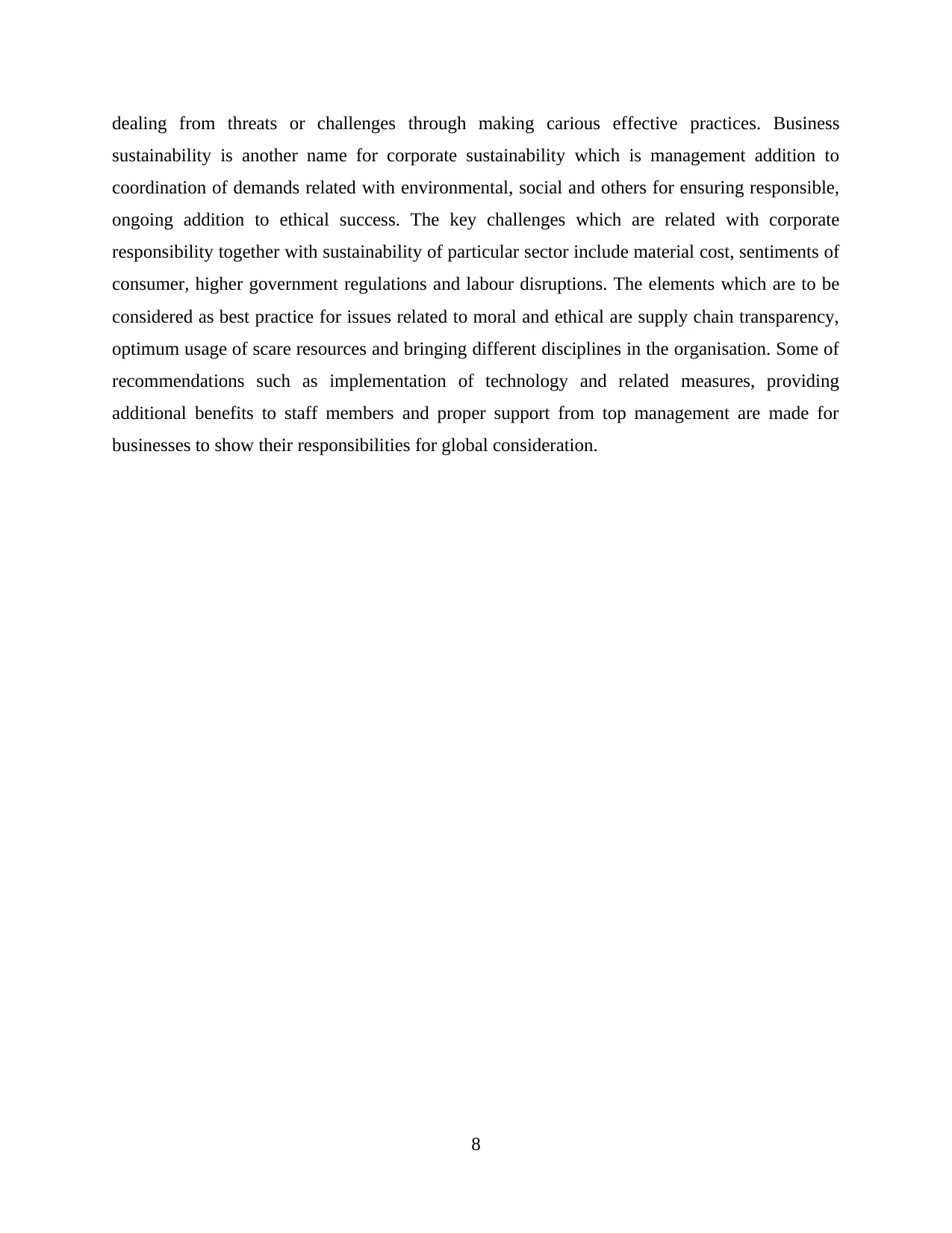
dealing from threats or challenges through making carious effective practices. Business
sustainability is another name for corporate sustainability which is management addition to
coordination of demands related with environmental, social and others for ensuring responsible,
ongoing addition to ethical success. The key challenges which are related with corporate
responsibility together with sustainability of particular sector include material cost, sentiments of
consumer, higher government regulations and labour disruptions. The elements which are to be
considered as best practice for issues related to moral and ethical are supply chain transparency,
optimum usage of scare resources and bringing different disciplines in the organisation. Some of
recommendations such as implementation of technology and related measures, providing
additional benefits to staff members and proper support from top management are made for
businesses to show their responsibilities for global consideration.
8
sustainability is another name for corporate sustainability which is management addition to
coordination of demands related with environmental, social and others for ensuring responsible,
ongoing addition to ethical success. The key challenges which are related with corporate
responsibility together with sustainability of particular sector include material cost, sentiments of
consumer, higher government regulations and labour disruptions. The elements which are to be
considered as best practice for issues related to moral and ethical are supply chain transparency,
optimum usage of scare resources and bringing different disciplines in the organisation. Some of
recommendations such as implementation of technology and related measures, providing
additional benefits to staff members and proper support from top management are made for
businesses to show their responsibilities for global consideration.
8
Paraphrase This Document
Need a fresh take? Get an instant paraphrase of this document with our AI Paraphraser
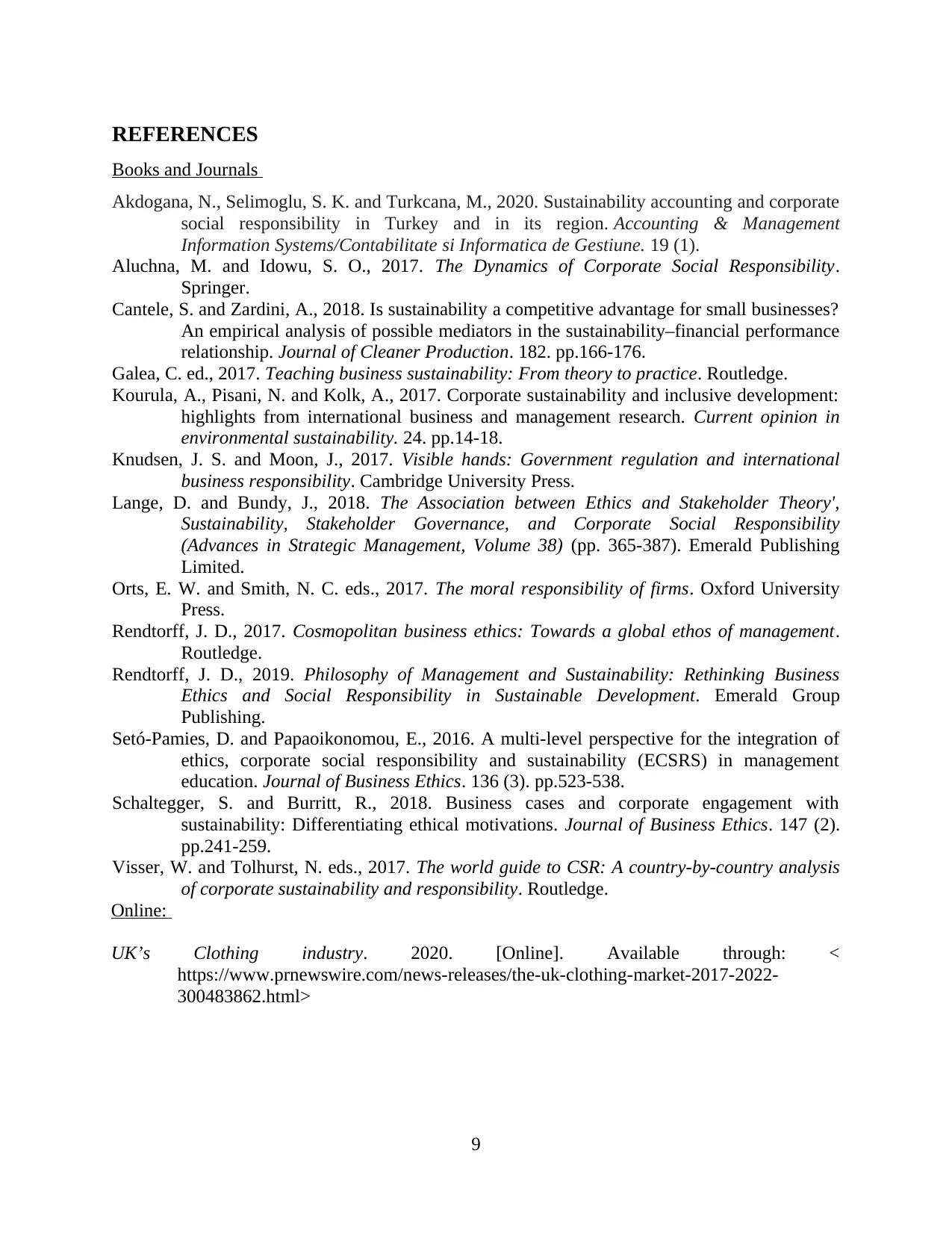
REFERENCES
Books and Journals
Akdogana, N., Selimoglu, S. K. and Turkcana, M., 2020. Sustainability accounting and corporate
social responsibility in Turkey and in its region. Accounting & Management
Information Systems/Contabilitate si Informatica de Gestiune. 19 (1).
Aluchna, M. and Idowu, S. O., 2017. The Dynamics of Corporate Social Responsibility.
Springer.
Cantele, S. and Zardini, A., 2018. Is sustainability a competitive advantage for small businesses?
An empirical analysis of possible mediators in the sustainability–financial performance
relationship. Journal of Cleaner Production. 182. pp.166-176.
Galea, C. ed., 2017. Teaching business sustainability: From theory to practice. Routledge.
Kourula, A., Pisani, N. and Kolk, A., 2017. Corporate sustainability and inclusive development:
highlights from international business and management research. Current opinion in
environmental sustainability. 24. pp.14-18.
Knudsen, J. S. and Moon, J., 2017. Visible hands: Government regulation and international
business responsibility. Cambridge University Press.
Lange, D. and Bundy, J., 2018. The Association between Ethics and Stakeholder Theory',
Sustainability, Stakeholder Governance, and Corporate Social Responsibility
(Advances in Strategic Management, Volume 38) (pp. 365-387). Emerald Publishing
Limited.
Orts, E. W. and Smith, N. C. eds., 2017. The moral responsibility of firms. Oxford University
Press.
Rendtorff, J. D., 2017. Cosmopolitan business ethics: Towards a global ethos of management.
Routledge.
Rendtorff, J. D., 2019. Philosophy of Management and Sustainability: Rethinking Business
Ethics and Social Responsibility in Sustainable Development. Emerald Group
Publishing.
Setó-Pamies, D. and Papaoikonomou, E., 2016. A multi-level perspective for the integration of
ethics, corporate social responsibility and sustainability (ECSRS) in management
education. Journal of Business Ethics. 136 (3). pp.523-538.
Schaltegger, S. and Burritt, R., 2018. Business cases and corporate engagement with
sustainability: Differentiating ethical motivations. Journal of Business Ethics. 147 (2).
pp.241-259.
Visser, W. and Tolhurst, N. eds., 2017. The world guide to CSR: A country-by-country analysis
of corporate sustainability and responsibility. Routledge.
Online:
UK’s Clothing industry. 2020. [Online]. Available through: <
https://www.prnewswire.com/news-releases/the-uk-clothing-market-2017-2022-
300483862.html>
9
Books and Journals
Akdogana, N., Selimoglu, S. K. and Turkcana, M., 2020. Sustainability accounting and corporate
social responsibility in Turkey and in its region. Accounting & Management
Information Systems/Contabilitate si Informatica de Gestiune. 19 (1).
Aluchna, M. and Idowu, S. O., 2017. The Dynamics of Corporate Social Responsibility.
Springer.
Cantele, S. and Zardini, A., 2018. Is sustainability a competitive advantage for small businesses?
An empirical analysis of possible mediators in the sustainability–financial performance
relationship. Journal of Cleaner Production. 182. pp.166-176.
Galea, C. ed., 2017. Teaching business sustainability: From theory to practice. Routledge.
Kourula, A., Pisani, N. and Kolk, A., 2017. Corporate sustainability and inclusive development:
highlights from international business and management research. Current opinion in
environmental sustainability. 24. pp.14-18.
Knudsen, J. S. and Moon, J., 2017. Visible hands: Government regulation and international
business responsibility. Cambridge University Press.
Lange, D. and Bundy, J., 2018. The Association between Ethics and Stakeholder Theory',
Sustainability, Stakeholder Governance, and Corporate Social Responsibility
(Advances in Strategic Management, Volume 38) (pp. 365-387). Emerald Publishing
Limited.
Orts, E. W. and Smith, N. C. eds., 2017. The moral responsibility of firms. Oxford University
Press.
Rendtorff, J. D., 2017. Cosmopolitan business ethics: Towards a global ethos of management.
Routledge.
Rendtorff, J. D., 2019. Philosophy of Management and Sustainability: Rethinking Business
Ethics and Social Responsibility in Sustainable Development. Emerald Group
Publishing.
Setó-Pamies, D. and Papaoikonomou, E., 2016. A multi-level perspective for the integration of
ethics, corporate social responsibility and sustainability (ECSRS) in management
education. Journal of Business Ethics. 136 (3). pp.523-538.
Schaltegger, S. and Burritt, R., 2018. Business cases and corporate engagement with
sustainability: Differentiating ethical motivations. Journal of Business Ethics. 147 (2).
pp.241-259.
Visser, W. and Tolhurst, N. eds., 2017. The world guide to CSR: A country-by-country analysis
of corporate sustainability and responsibility. Routledge.
Online:
UK’s Clothing industry. 2020. [Online]. Available through: <
https://www.prnewswire.com/news-releases/the-uk-clothing-market-2017-2022-
300483862.html>
9
1 out of 11
Related Documents
Your All-in-One AI-Powered Toolkit for Academic Success.
+13062052269
info@desklib.com
Available 24*7 on WhatsApp / Email
![[object Object]](/_next/static/media/star-bottom.7253800d.svg)
Unlock your academic potential
Copyright © 2020–2025 A2Z Services. All Rights Reserved. Developed and managed by ZUCOL.





